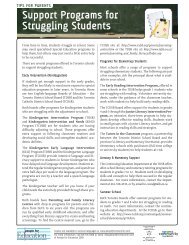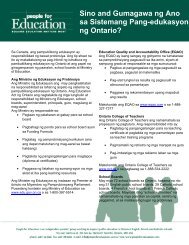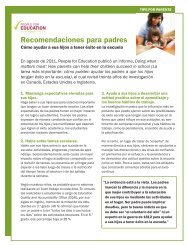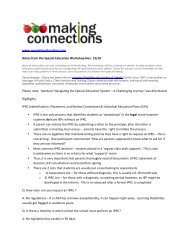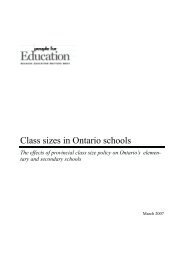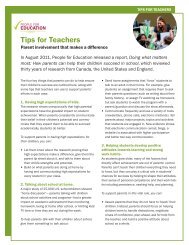Our Children Our Future Our Vision - People for Education
Our Children Our Future Our Vision - People for Education
Our Children Our Future Our Vision - People for Education
You also want an ePaper? Increase the reach of your titles
YUMPU automatically turns print PDFs into web optimized ePapers that Google loves.
<strong>Our</strong> <strong>Children</strong>, <strong>Our</strong> <strong>Future</strong>, <strong>Our</strong> <strong>Vision</strong><br />
between INAC and First Nations in Ontario and includes representation from both.<br />
Funding <strong>for</strong> the Special <strong>Education</strong> Program (SEP) is a targeted allocation, meaning that funding<br />
is a full and final allocation that can only be spent on First Nation students who ordinarily reside<br />
on reserve and are assessed by an appropriate professional as having moderate to profound<br />
special needs not met within existing education programming and services. The yearly allocation<br />
<strong>for</strong> each First Nation is distributed at the outset of the fiscal year after Profound Ministry school<br />
costs are deducted. 165 The total funding allocation <strong>for</strong> Ontario in 2011-12 was $25,621,718. Of this<br />
total $1,779,766 was deducted <strong>for</strong> Profound Ministry schools, leaving $23,841,952 to be distributed<br />
among the First Nations as per the Special <strong>Education</strong> Funding Formula.<br />
The funding <strong>for</strong>mula includes a base amount (based on the nominal roll from the previous year), a<br />
Special <strong>Education</strong> incidence rate, a northern factor, a remoteness factor, and a small school factor.<br />
First Nations manage this allocation based on local education policies and the Special <strong>Education</strong><br />
needs of their students who attend both provincially funded schools and First Nation schools. However,<br />
a recent focus group session conducted by the OFNSEWG with front line special education<br />
administrators uncovered some glaring communication gaps at all levels which impact funding.<br />
These gaps contribute to inaccurate coding and misunderstanding of what the SEP is intended to<br />
cover; especially in the case where First Nations are paying tuition costs <strong>for</strong> students attending<br />
provincial schools. Focus group participants also drew attention to the fact that the audits do not<br />
reflect the inability of some First Nation communities to access the required expertise to assess<br />
student needs and there<strong>for</strong>e many potential special education students remain unidentified. The<br />
OFNSEWG continues to gather data to determine if the SEP allocation is sufficient to meet the<br />
needs of First Nations in Ontario.<br />
Canada must acknowledge and resolve the shortcomings of the audit process <strong>for</strong> the Special <strong>Education</strong><br />
Program in order to ensure adequate funding is provided through a flexible funding authority<br />
based on valid in<strong>for</strong>mation.<br />
165 These are schools <strong>for</strong> the deaf and blind.<br />
Chiefs of Ontario<br />
38



